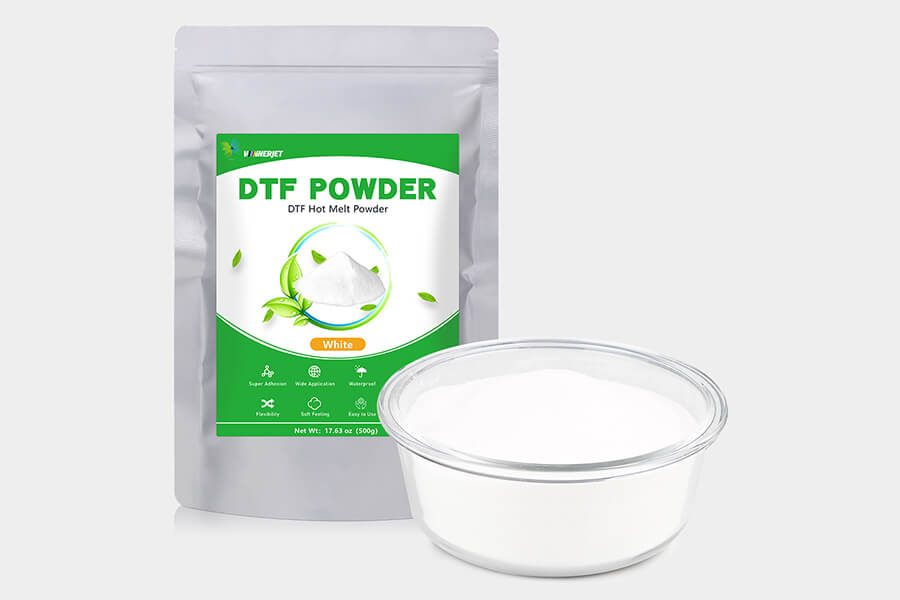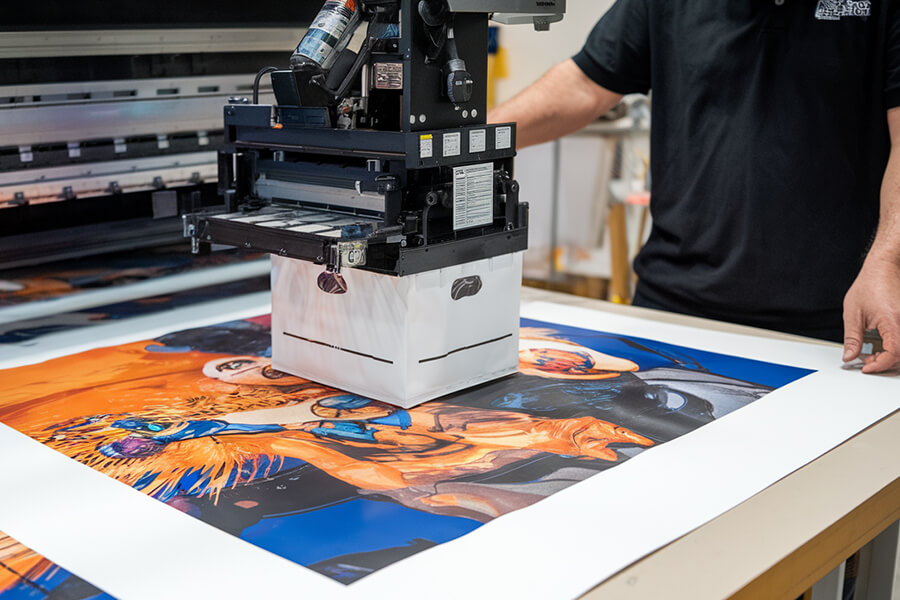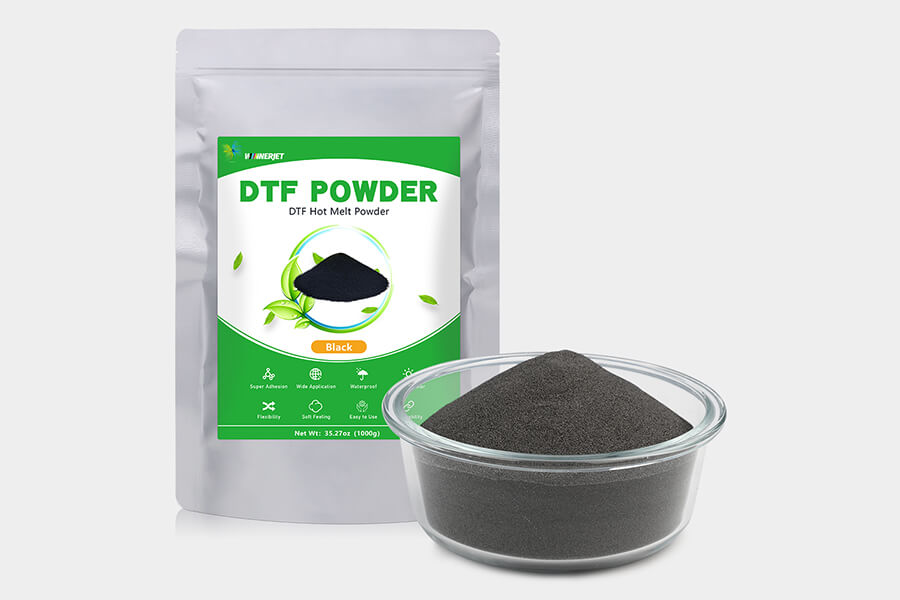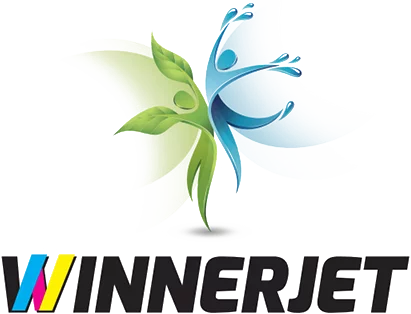DTF Holt Melt Powder acts as a binder, bonding the printed design to the fabric, and is an integral part of the DTF (direct-to-film) printing process. Its adaptability makes it perfectly compatible with all DTF Printers, DTF Ink, and other DTF necessities, such as DTF Films. It allows companies to obtain prints with vibrant and long-lasting colors. Through this blog post, we will get to grips with the composition of DTF powder, its uses, and practical tips for printing.
What is DTF Powder?
DTF powder is a unique substance used in the textile printing industry to enhance the transfer of patterns from the print medium (usually film) onto various fabrics. The powder, which is applied as a thin layer on top of the printing ink on the film, plays a vital role in the heat transfer process, ensuring that the ink adheres firmly to the fabric, resulting in a vibrant and long-lasting print effect.
What is DTF powder made of?

DTF powder, also known as hot melt adhesive powder. It usually consists of the following components: polyurethane, resin, pigment,s and other additives. When heated, the ink is bonded to the fabric and helps fix the printed pattern by melting during heat transfer.
What are the Types of DTF Powder?
Fine DTF Powder
- Suitable for all DTF printers, compatible with all DTF inks and DTF Film, excellent compatibility.
- Commonly used capacity of 1kg (2.2lb) of powder per bag for high-volume printing needs.
- Made from specially formulated thermoplastic polyurethane (TPU) designed for transfer printing applications.
Medium particle size DTF powder
- Provides good coverage and ease of use for a wide range of fabrics and print projects.
- Suitable for general-purpose printing such as t-shirts, sweatshirts, backpacks, and other textiles.
Coarse DTF Powder
- Has a larger particle size that provides strong adhesion and durability.
- Ideal for challenging print conditions and heavy-duty applications such as outdoor applications, sportswear, and other high-wear items.
Polyurethane (TPU)
- Known for its elasticity and flexibility, it is commonly used where stretchable materials are required, such as sportswear and activewear.
Polyester (PES)
- Suitable for printing on polyester fabrics, offering excellent color vibrancy and adhesion.
Polyamide (PA)
- Suitable for printing on nylon fabrics, offering good adhesion and durability.
How does DTF powder work?
Required equipment
- DTF Printer
- Automatic Powder Shaker Machine
- Curing Oven
- Heat Press Machine
- DTF Ink
- DTF Transfer Film
- DTF Powder
- Substrate (material to be printed)
Step-by-Step Guide
- Printing the pattern: Print the designed pattern onto the transfer film using special DTF ink through a compatible DTF printer.
- Apply Powder: Apply the DTF powder evenly to the printed transfer film to cover the pattern completely.
- Shake the powder: Leave the powder adhering to the printed pattern and shake the excess powder from the film into the powder collector.
- Curing: The powder is heated in the oven to fully heal and form a transfer layer on the transfer film.
- Heat transfer: Put the transfer film with DTF powder on the substrate, heat the heat press, and press it to transfer the pattern to the substrate by heat.
- Peeling off: Tear off the transfer film on the substrate carefully to complete the pattern transfer.
Please read ‘What is DTF Printing‘ for more information about DTF printing.
What are the advantages of DTF powders?

- High-quality prints: Prints made with DTF powder have bright colors, rich and vivid details, and high reproduction.
- Versatility: DTF powders can be used on various materials such as cotton, polyester, leather, nylon, blends, silk, ceramics, and more. It is suitable for both light and dark-colored fabrics.
- Durability: DTF powder brushes have high color fastness, wear and wash resistance, and can be washed more than 60 times without fading.
- Ease of use: The DTF powder coating process is simple and suitable for detailed and complex designs.
- Reduced production time: DTF powders simplify the production process through direct printing and transfer, which is faster than traditional methods.
- Cost-effective: DTF powder is ideal for moving from small customized batches to high-volume production without significant cost increases.
- Environmentally friendly: Some DTF powders are water-based, making them more environmentally friendly than traditional plastic inks used in screen printing.
What are the disadvantages of DTF powders?

- Equipment requirements: using DTF powder for transferring requires specific DTF printers, heat presses, and other equipment, which makes the initial investment cost higher for companies.
- Learning curve: DTF printing is easy to operate compared to other printing methods, but to get and maintain the best results, you still have to learn and master the machine operation and process knowledge.
- Limited breathability: The use of DTF powder reduces the breathability of the fabric and may make the fabric stiff.
- Poor touch: DTF powder slightly bumps the print, resulting in a less soft hand.
Difference between black and white DTF powder
White DTF powder
- Mainly used for light or white fabrics as it provides good color saturation and opacity.
- Often used in designs that require a white base layer to enhance the color vibrancy and contrast.
- It can reduce the amount of white ink used, thus reducing costs.
- Suitable for a wide range of fabrics, including cotton, polyester, nylon, leather, EVA, blends, and more.
Black DTF powder
- Usually used for dark or black fabrics as it effectively masks the base color and provides a more precise pattern.
- Suitable for designs that require strong contrast and color impact.
- More durable than white powder, especially when rubbed or washed frequently.
What are the applications of DTF powder?

- Customized clothing: for printing graphics on personalized T-shirts, hoodies, sportswear, and other types of clothing.
- Home Textiles: DTF powders transfer graphics onto home décor fabrics such as curtains, bed sheets, and tablecloths.
- Promotional products: Companies use DTF powder to print logos and graphics on promotional products such as bags, hats, and umbrellas.
- Accessories: DTF powders print graphics on various accessories, including mobile phone cases, laptop sleeves, and luggage tags.
- Signs and banners: for durable and brightly colored signs, banners, and trade show displays.
- Industrial applications: DTF powders can print on synthetic materials in some industrial environments or produce durable labels and tags.
- Footwear: Used to print graphics on shoe materials to enhance customization options for footwear manufacturers.
- Sports accessories: These are used to print logos and graphics on sports equipment, such as cycling apparel, yoga mats, and gym bags.
How do you choose the suitable DTF powder?

Choosing the suitable DTF powder is critical to ensuring the quality and durability of your printing results. Below are some key factors that help you select the suitable DTF powder for your product.
- Fabric type: Different fabrics may require different formulations of DTF powder for optimal bonding. For example, fine DTF powders are suitable for delicate fabrics, while coarse DTF powders are suitable for coarser textured fabrics.
- Powder particle size: The DTF powder’s size affects the print’s feel and durability. Finer DTF powders can provide a softer feel, while coarser DTF powders may increase print durability.
- Color and opacity: White DTF powders may provide better color saturation and opacity for light-colored fabrics. For darker fabrics, black or clear DTF powder may be required to prevent fabric colors from bleeding.
- Environmental considerations: Choosing an environmentally friendly and non-toxic DTF powder ensures the safety of the work environment and the wearer.
- Cost-effectiveness: While high-quality DTF powders may cost more, they usually offer better print quality and durability, resulting in lower long-term costs.
- Brands and suppliers: Choose reputable brands and suppliers who can provide technical support and after-sales service to ensure the quality and performance of the powder.
- User Evaluation: Refer to other users’ evaluations and experiences to understand the performance and effects of different DTF powders.
- Tests and experiments: Test the DTF powder on a small scale before mass production to ensure it meets your printing needs and quality standards.
What can we offer?
Winnerjet is a printing consumables factory. We offer white and black DTF Powder in 500G and 1000G sizes. You can visit our shop for our high-quality DTF Powder and contact customer service for professional technical support.
Conclusion
DTF powder plays a vital role in the DTF printing process, ensuring high-quality and sophisticated graphics. Despite some challenges, its benefits make it an invaluable tool for businesses engaged in custom printing.
As with all printing methods, mastering DTF printing requires constant hands-on practice and a thorough knowledge of the equipment and materials. By using different types of DTF powders and following the recommended steps, a new world of custom printing opens up for your business.
FAQS
Is DTF powder toxic?
DTF powders are made from environmentally friendly, non-toxic ingredients and are often labeled as non-toxic themselves. However, proper safety measures should be taken. When working with DTF powder, adequate ventilation, air filtration, fume exhaust, and personal protective equipment are necessary.
Can you use DTF powders on sublimation paper?
DTF powder cannot be applied directly to sublimation paper, designed for the DTF printing process, whereas sublimation paper is designed for the sublimation printing process.
At what temperature is the DTF powder cured?
Different types of DTF powders may have different melting points and curing temperatures. DTF powders are typically cured at melting points in the range of 105-115°C (131.4°F-149.4°F), and hot pressing temperatures between 110-130°C (140.4°F-176.4°F) are recommended. The melting point of thermoplastic polyurethanes (TPU) is typically 105-115°C (131.4°F-149.4°F). Thermoplastic polyesters have a melting point of 125-135°C (167.4°F-185.4°F).
What is the shelf life of DTF powder?
The shelf life of DTF powder is usually around 12 months under proper storage conditions. The best results are achieved when used during this period.




